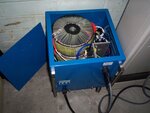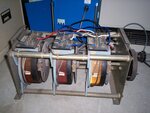Barry675
Newbie level 3
Hello,
I need to build a fixed voltage DC power supply to emulate a large lithium-ion battery pack in order to drive an inverter as part of an evaluation test bed.
I would like to rectify 400V 3-phase power and use this to make a fixed 565V DC power supply. I would appreciate any guidance on this. Is it as straightforward as implementing a 3-phase full wave rectifier circuit and then put sufficient capacitance on the output to meet my target ripple voltage? The power rating of the converter needs to be about 10 kW.
I have chosen this idea as it seems to be the simplest solution and will not be excessively expensive (~€1k). Are there better similarly price off the shelf solutions in this range?
I am not familiar with the electrical behaviour of large lithium-ion battery packs but do they display much ripple? Can anyone suggest a target ripple % for rectifier? There's no point in making it have 1% ripple at max load if a battery pack will have 10%.
Can anyone suggest any references or guides on what the best accepted practices for such a device are? What is the state of the art in this area - I see quite a bit about active power factor correction but I'm not sure if this is necessary.
Any advice would be greatly appreciated,
Barry
I need to build a fixed voltage DC power supply to emulate a large lithium-ion battery pack in order to drive an inverter as part of an evaluation test bed.
I would like to rectify 400V 3-phase power and use this to make a fixed 565V DC power supply. I would appreciate any guidance on this. Is it as straightforward as implementing a 3-phase full wave rectifier circuit and then put sufficient capacitance on the output to meet my target ripple voltage? The power rating of the converter needs to be about 10 kW.
I have chosen this idea as it seems to be the simplest solution and will not be excessively expensive (~€1k). Are there better similarly price off the shelf solutions in this range?
I am not familiar with the electrical behaviour of large lithium-ion battery packs but do they display much ripple? Can anyone suggest a target ripple % for rectifier? There's no point in making it have 1% ripple at max load if a battery pack will have 10%.
Can anyone suggest any references or guides on what the best accepted practices for such a device are? What is the state of the art in this area - I see quite a bit about active power factor correction but I'm not sure if this is necessary.
Any advice would be greatly appreciated,
Barry

